Clash of Titans
Games featuring a future Hall of Fame coach on each sideline.
October 20, 1928: Tennessee @ Alabama
Robert Neyland vs Wallace Wade
When Tennessee needed an assistant coach for football in 1925, the school also had a vacancy in the military department. So Dean N. W. Dougherty wrote a letter to John McEwan, the head coach at West Point and asked him to "recommend a man that we might get here in our military that could aid us in our coaching." McEwan wrote back, "Captain Neyland is a excellent prospect as a coach. He is a maker of ends." Many years later, Dougherty said hiring Robert Neyland was "the best move I ever made."
After just one year as an assistant at Tennessee, Neyland replaced M. B. Banks as head coach (which was Dougherty's intention all along).
Neyland's first move as head coach was to hire two former Army teammates, William Britton and Paul Parker, to assist him. He assigned Britton to coach the ends and Parker, the line.
The new coach's priorities became evident in spring practice, which began in February. The first three weeks were for punters only, and Neyland himself did the tutoring. The school newspaper wrote: "He is determined that Tennessee will not lose any games during the coming season because of a lack of good punting."
The second phase, the last week of February, was for freshmen and other newcomers. The veterans reported the first week in March.
Neyland's first Vol team won eight of nine games, the only loss coming at the hands of Tennessee's cross state nemesis, Vanderbilt. The 1927 Volunteers did slightly better, winning eight games and tying one with the Commodores. That was good enough for second place in the Southern Conference behind Georgia Tech.
Neyland was responsible for innovations that we take for granted today.
-- The first southern coach to move the quarterback under center for some plays instead of snapping the ball back to the tailback in the single wing.
-- The first southern coach to use telephones during games to get reports from his assistants in the press box who had a wide view of the action on the field.
-- The concept of the "passing pocket" for blockers to keep the rushers off the quarterback.
-- The six-man defensive line.
-- Use of a stopwatch to time his passers and punters during pre-game warmups to see how quickly they threw or kicked the ball.
-- Outfitting his players in lightweight jerseys and pads.
-- The first southern coach to move the quarterback under center for some plays instead of snapping the ball back to the tailback in the single wing.
-- The first southern coach to use telephones during games to get reports from his assistants in the press box who had a wide view of the action on the field.
-- The concept of the "passing pocket" for blockers to keep the rushers off the quarterback.
-- The six-man defensive line.
-- Use of a stopwatch to time his passers and punters during pre-game warmups to see how quickly they threw or kicked the ball.
-- Outfitting his players in lightweight jerseys and pads.
Neyland was impressed with the rising sophomores who participated in the spring practice of 1928. "We'll have a fast team and should make the most of it," he wrote in his ledger. "Marked by individual improvement. McEver shows great promise."
Featured Player
Neyland had to work hard to recruit Gene McEver, who had a fantastic high school career in Bristol VA. He was already in school at Wake Forest when Neyland sent assistant coach Britton to Winston-Salem NC. "I told the Wake Forest people that I figured I'd be happier at Tennessee," McEver recalled in 1983. "They tried to get me to stay in Winston-Salem, but my mind was already changed. When Coach Britton told me Tennessee still wanted me, even after I had turned them down for Wake Forest, well, that made me realize how important I was to them."
McEver, whom the newspapers would dub the "Bristol Blizzard" and the "Wild Bull," would set the Tennessee career scoring record for non-kickers.
He became a unanimous All-America halfback for three years: 1928, 1929, and 1931. (Knee surgery sidelined him for 1930.) In 1929, he led the nation in scoring with 130 points.
McEver was inducted into the College Football Hall of Fame in 1954.
|
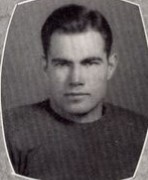 (Tennessee Volunteer Yearbook Class of 1929) |
The Vols easily won their first two games of the '28 season, 41-0 over Maryville and 41-7 over Centre. Then they struggled against Ole Miss, eking out a 13-12 win when the pass for the tying extra point was knocked down. Were the Vols looking ahead to their next foe, Alabama, which defeated the Rebels 27-0 the week before?
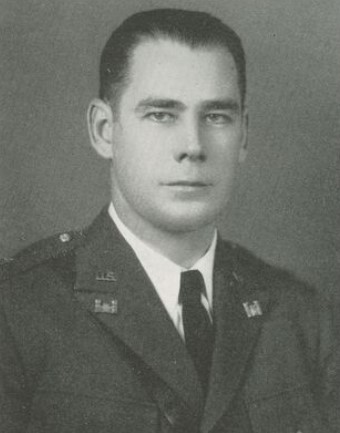
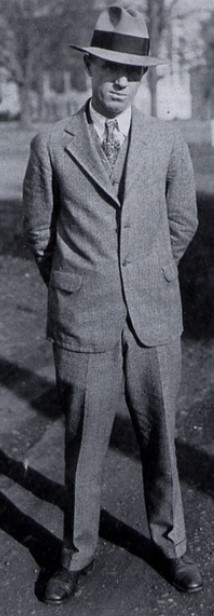
L: Robert Neyland (Tennessee Volunteer Yearbook Class of 1930)
R: Wallace Wade (Alabama Corolla Yearbook Class of 1929)
Tennessee's 16-1-1 record the last two seasons was hardly known anywhere outside the state of Tennessee. The Volunteers needed a win over somebody big, and nobody was bigger than Alabama, which had played in the Rose Bowl in 1925 and 1926. Neyland's bold move to schedule the Crimson Tide would give the national press reason to take note of the upstart Volunteers.
It hadn't taken Wallace Wade long to bring the Crimson Tide to the top of the football world. His 1925 team finished the season 9-0 with seven shutouts. That earned them an invitation to the Rose Bowl where they edged Washington 20-19 in what has been called "the most important game in Southern football history" because it changed the national perception of Southern football as inferior to the rest of the nation.
The 1926 Alabama season was almost a carbon copy of '25. The Tide again won all nine of their games to earn another trip to Pasadena, where they tied Pop Warner's Stanford Indians 7-7.
1927 was a rebuilding year for Wade's team. The loss to Georgia Tech in Game 4 ended the Tide's 24-game unbeaten streak. The disappointing season ended with a 5-4-1 record. The four losses were one more than Bama had suffered in the previous four seasons combined.

Alabama 1928 Starting Lineup
Backs L-R: Billy Hicks, Vines, John Campbell, John Henry Suther
Line L-R: Sam Weaver, Earl Smith, John Miller, Jess Eberdt, Ellis Hagler, Fred Sington, Molton Smith
(University of Alabama Corolla Yearbook, Class of 1929)
Tennessee did not play Alabama in Neyland's first three seasons as head coach. They hadn't played since 1914 when Tennessee won 17-7 in Knoxville. The rivalry was renewed in 1928 and has been played on the third Saturday in October ever since with few exceptions (such as the war year of 1943).
Neyland was responsible for the resumption of the series. Tom Siler, longtime sports editor at the Knoxville News Sentinel, explained: "Neyland wanted Tennessee to step into the football limelight like Alabama. Alabama had been to two Rose Bowls. Neyland thought playing them could gain national attention for his Volunteers."
In addition to the 27-0 thumping of Ole Miss, the 1928 Alabama team clobbered Mississippi A&M 46-0. The Tide appeared to have returned to the level of the 1924-25 Rose Bowl aggregations. The decks were cleared for the first meeting with Tennessee in 14 years.
Based on the comparative scores against Ole Miss, the experts expected Tennessee to lose by two or three touchdowns. Bama adherents were betting five to one on their team to win, with even money that they would win by 28 points, and even money that the Vols would not score.
Vol Quarterback Hurt
To make matters worse, Tennessee would play the game in Tuscaloosa with a sophomore quarterback calling signals. Neyland had groomed senior Roy Witt to run the single wing offense. But a shoulder injury knocked him out of action. That thrust sophomore Bobby Dodd into the starting position. The future Hall of Fame coach at Georgia Tech had considered transferring. "I was very depressed," Dodd recalled. "It looked like the captain of the football team was gonna play my position. He was a punter, Roy Witt." Dodd didn't have any particular school in mind when he considered transferring. "Just anybody who wanted me." Then everything changed. "I'll be dad-gum if Roy Witt didn't get hurt, and Neyland had no choice but to put me in."
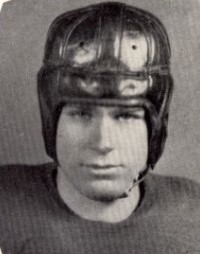
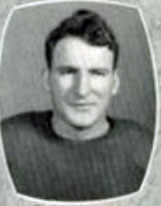

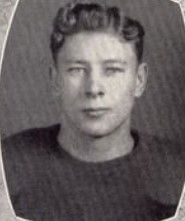
The Tennessee Backfield
L-R: Captain Roy Witt, Gene McEver, "Farmer" Johnston, Bobby Dodd, Buddy Hackman
(University of Tennessee The Volunteer Yearbook Class of 1929)
"I wasn't the slowest man on the football team," recalled Dodd, "but I was close, and in single-wing football, where in the hell you are gonna put someone who can't run a lick? But they had to put me in there because back in those days, you couldn't substitute a punter. Your punter had to be already out there. And he had to play. You take a guy out of the game, he's out."
"So when Witt got hurt, I'm the kicker. And I'm a good kicker. Neyland likes me as a kicker, and he likes me as a passer. But he didn't like me a damn bit as a runner, and I wasn't much of a blocker."
Dodd became the seventh sophomore from the undefeated freshman team of 1927 to start for Neyland. After the Alabama game, they would be called the "Flaming Sophomores."
Dodd wrote in his autobiography: "Alabama in Tuscaloosa. That's big stuff. That was our first big game. Everybody tells us Alabama is going back to the Rose Bowl again. Alabama had a great team. The betting odds said $500 even-money Tennessee wouldn't even score."
Southern Railroad ran special trains to Tuscaloosa. The bleachers on both sides of the field filled up quickly. Fans without seats circled the playing field.
Neyland met Wade for the first time on the field before the game and used a bit of reverse psychology on him. Neyland suggested to Wade that the third and fourth quarters be cut short if Alabama had a sizeable lead. Wade replied that he didn't expect to run up a big score, but if so, he'd shorten the second half.
Neyland wrote the names of the Alabama players on a chalkboard in the locker room. He looked every Tennessee starter in the eye and challenged him to beat his man.
He also told his players not to look at Alabama when the Tide came on the field. But if you tell people not to do something, they'll do it. One of the sophomores, Buddy Hackman, recalled what he saw: "They were wearing white jerseys that made 'em look like elephants. Neyland had thought that would put the fear of the Lord in us, like you were in a prize fight and nobody told you how big the other guy was. But we weren't scared of anybody, even if we were about 20 pounds lighter a man." The game would be a classic matchup of speed against size.
On the train from Knoxville to Tuscaloosa, Neyland called each player into his private compartment.
"He talked to us about our preparation, about our assignments, about what it meant to win a big football game," said TB Gene McEver. "But I guess the most important thing he said was that we were better, man for man, than the Alabama players."
McEver Predicts Kickoff Return
Dodd's roommate the night before the game was fellow sophomore McEver, who wasn't scared in the least. As Babe Ruth would do four years later in the World Series against the Cubs when he pointed to the bleachers, then hit a home run to that spot, McEver displayed the same confidence bordering on cockiness. Referring to himself in the third person, he told Dodd, "If they kick that ball off to ol' Gene, he's gonna run it back for a touchdown."
In the locker room before the game the next day, McEver told his teammates, "If I get that ball on the kickoff, everybody try to cut down a man. If you can't cut down a man, just move over and let me through."
Sure enough, the Vols won the toss and elected to receive. As they went to their positions on the field, Dodd and McEver shook hands. What happened next remains one of the most memorable plays in Tennessee football history.
McEver took the kick on the two and behind good interference streaked upfield until he broke into the open. Two Alabama men snatched at him futilely as he raced to the end zone. Dodd placekicked the extra point. Just like that Tennessee led 7-0.
McEver recalled: "After our guys knocked down nine of their guys, I saw two Alabama players standing in the alley in the middle of the field. They were on about the 50y line. I went right between them, split them in half, bowed my neck and let them have it. That's all I could do. Then I was clear and runnig for the goal lie. I don't even know if anybody gave chase."
Alabama halfback John Henry Suther recalled: "In one regard, McEver was like a cannonball, literally rolling over people. Then he was like a bullet, too speedy to catch. ... His run kind of took the zing out of us and gave them a lot of enthusiasm. It was a wild scene that day. The return of the series was big news in both Alabama and Tennessee. I can remember being terribly excited the week of the game. And, of course, I never considered the prospects of us losing."
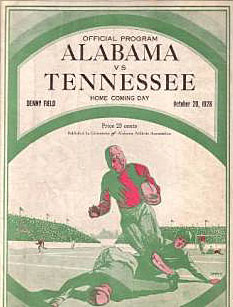 |
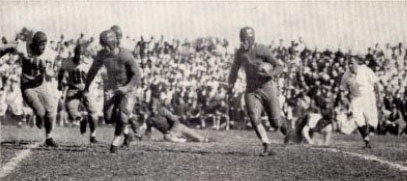 Gene McEver returns the opening kickoff for a touchdown. (University of Tennessee The Volunteer Yearbook Class of 1929) |
Back in Knoxville, Pat Roddy used a megaphone relay the play-by-play from Tuscaloosa to Tennessee fans. He got his information from a telegraph operator. Some fans refused to believe what was happening as the game progressed and hooted him and yelled at him as if they thought he was spoofing them.
Bama Scores
Alabama came right back with a touchdown of their own. Bama took Dodd's kickoff on the five and returned to the 45. Suther hit tackle for 6y and on the next play broke through the same spot and raced 49y for a touchdown. However, Bama missed the PAT. 7-6 Tennessee
Suther said years later: "I was so pumped up that I still don't recall my touchdown run very clearly."
Dodd's Punt Leads to Safety
Near the end of the first quarter, Dodd, Neyland's prize pupil from his Spring School of Punting, kicked one out of bounds on the Alabama 1' line. Suther immediately backed up behind his goal line to punt. But with several Volunteers charging, he fumbled the snap and the ball went back across the end line for a safety. 9-6 Tennessee
"I had never punted in my life," said Suther. "I made a costly error. I've thought about that fumble a lot through the years."
Vols Extend Lead
Midway through the second quarter, Tennessee marched 72y for their second touchdown. The big gainer was McEver's 22y run. Three plays later, McEver gained eight for a first down on the Bama 30. Then HB Buddy Hackman threw a pass to E Paul Hug to put the ball on the eight.
The Tide stuffed McEver for no gain, but an offside penalty negated the play and put the ball on the four. From there, Hackman tossed a flat pass to McEver who scampered into the end zone. Dodd missed the extra point. Tennessee 15-6
"We still had hope," recalled Suther. "If we had quit, Wade would have killed us. And, of course, it was Tennessee we were playing."
Tide Answers Again
As they did after Tennessee's first touchdown, the Tide answered with a six-pointer of their own. On the first play after the kickoff, Davis Brasfield rammed through the line and broke into the clear for 57y to the UT 15. From there it was brute force, with the big Alabama line pushing the lighter Volunteers back. Still, it took six smashes before Tony Holm went over for the touchdown. Dave Boykin's kick went astray, but Tennessee was offside. So under the rules of the day, the point counted to cut the Tennessee lead to 15-13.
On the final play of the first half, Alabama punted. Neyland had given strict orders to fair catch all punts. But Dodd, trying to make something happen, caught the ball and was bulldozed by two 220lb Bama players, Fred Sington and Molton Smith. "They hit me in the back as I twisted and hurt my kidney," Dodd recalled. He was carried off on a stretcher to the locker room where Neyland reprimanded him for fielding the punt. Dodd missed the entire second half. "The only time I was hurt in my whole career. Hurt me bad. I passed blood, and they were afraid to let me play. I didn't play for about the next four weeks."
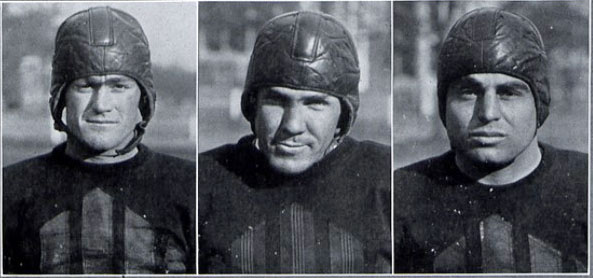
Three Alabama Stars: L-R Billy Hicks, John Campbell, John Henry Suther
(University of Alabama Corolla Yearbook, Class of 1929)
Playing even more conservatively than usual with a lead and a third-string quarterback, the Vols would add no more points to their total. But somehow they managed to hold off Alabama in a seemingly endless second half. "They ran all over us," Dodd recalled, "but they couldn't score."
Midway through the third period, Bama moved to the UT 11. But after a loss of 2y, Brasfield fumbled, and "Farmer" Johnson jumped on the ball for Tennessee.
Hackman made several productive runs to move the ball out to the 45. But a 15y holding penalty set the Vols back before a pass from Charles Reineke to Hackman got that yardage back again. Hackman took a lateral for 7y to the Bama 48 as the period ended.
As dusk set in, fans turned on the headlights of their cars so the contest could continue.
The Tennessee thrust ended with an interception. The next time the Vols got the ball, it was on their 20. Reineke immediately punted back, but the ball traveled only to the UT 42.
Vols Stifle Every Bama Thrust
Alabama got one first down on Billy Hicks' 13y sweep, but the threat died when a fourth-down pass was broken up.
But after intercepting a pass, the Tide was back in business at the UT 42. Brasfield connected with Deal for 17y. With their fans yelling "Hold that line!" three Vols rushed Brasfield and forced a fumble.
With only a few minutes left, Alabama took to the air on their next possession only to have Reineke rack up another interception.
Neyland's offense ran some time off the clock before punting to the Bama 35.
Brasfield ripped off 18y off-tackle. Hicks added eight, and John Campbell made three more for a first down at the UT 36. On third-and-11, Campbell ran to the 15 as time expired.
Final score: Tennessee 15 Alabama 13
Major Neyland was so happy over the victory that he forgot the score. "I know we won," he told reporters, "but what was the score?"
Someone told him it was 15-13.
"Our boys played far better than we dreamed they would," said Neyland. "They made up for their lack of experience by their unquenchable fight. I'm so proud of them that I'd kiss every one of them if I wasn't afraid they would all take a poke at me when I tried."
Tennessee fans turned Gay Street in Knoxville into a wild scene that night. The celebration continued into the morning.
When the train carrying the Volunteers pulled into the station in Knoxville the next day, an enormous crowd greeted them, cheering madly.
The 1928 victory over Alabama has been called the most significant in Tennessee football history. That upset caused Tennessee football to be taken seriously. Gene McEver, who led the nation in scoring in 1928 with 130 points and would be enshrined in the National Football Foundation Hall of Fame, said years later, "I don't think there's any question about that game putting Tennessee football on the map."
Neyland earned Wade's respect that day. "First, he's a very brilliant man and had a lot of character and could influence young people. Inspire them. His teams were always well trained, well-conditioned, and played with spirit. One of the things I used to misjudge, I used to think he was lucky. But I began to realize after time that luck turns sometimes, but it never did with him because he trained his players to take advantage of opportunities."
Asked about his career in Knoxville, McEver replied: "I supposed the Alabama game in 1928 stands out the most. Not that that was the greatest game, but that was the game that put Tennessee on the map."
TB Buddy Hackman, one half of the "Hack and Mack" backfield with McEver, agreed that the '28 Alabama game was a shot in the arm for Tennessee football.
"Especially when you win a big one, that gives you the confidence that you always need. I expect that was our stepping stone."
References:
The Big Orange: A Story of Tennessee Football, Russ Bebb (1979)
Dodd's Luck: The Life and Legend of a Hall of Fame Quarterback and Coach, Robert Lee "Bobby" Dodd and Jack Wilkinson (1987)
Neyland: The Gridiron General, Bob Gilbert (1990)
Tennessee vs. Alabama Third Saturday in October: The Game-by-Game Story of the South's Most Intense Football Rivalry, Al Browning (2001)
Game Day Tennessee Football: The Greatest Games, Players, Coaches and Teams in the Glorious Tradition of Volunteer Football (2006)
100 Things Tennessee Fans Should Know & Do before They Die, Craig T. Smith (2015)
The Big Orange: A Story of Tennessee Football, Russ Bebb (1979)
Dodd's Luck: The Life and Legend of a Hall of Fame Quarterback and Coach, Robert Lee "Bobby" Dodd and Jack Wilkinson (1987)
Neyland: The Gridiron General, Bob Gilbert (1990)
Tennessee vs. Alabama Third Saturday in October: The Game-by-Game Story of the South's Most Intense Football Rivalry, Al Browning (2001)
Game Day Tennessee Football: The Greatest Games, Players, Coaches and Teams in the Glorious Tradition of Volunteer Football (2006)
100 Things Tennessee Fans Should Know & Do before They Die, Craig T. Smith (2015)